Abstract
Water conservation, as a critical ecosystem service, plays a vital role in maintaining regional water resources balance. Against the backdrop of rapid urbanization, the expansion of construction land has intensified the encroachment on ecological spaces, posing significant challenges to water resource carrying capacity. From a supply–demand perspective, this study employs the InVEST model and integrates multi-source data including meteorological and socio-economic datasets to construct models of water conservation supply and demand. Furthermore, spatial analysis methods are applied to examine the evolution of water resource carrying capacity in Gansu Province—a key region within the Yellow River Basin—from 2000 to 2020. The results indicate the following: (1) through desertification control, unused land has been progressively restored to grassland, yet continuous urban expansion has substantially encroached upon surrounding plowland and grassland; (2) the spatial pattern of water conservation supply exhibits a “high in the south and west, low in the north and east” distribution, with the maximum value per pixel increasing from 7.89 × 105 m3 to 8.15 × 105 m3. Overall, water resource carrying capacity has generally declined, with intensified pressure in central cities such as Lanzhou, while some improvement is observed in forested areas of the south; and (3) cold spots in the western Qilian Mountains have expanded toward the Hexi Corridor, reflecting significant spatial changes and indicating ecological degradation. Urbanization has markedly exacerbated regional imbalances in water resource carrying capacity, providing a scientific basis for water–ecological risk management in arid regions.
1. Introduction
The theory of ecosystem services posits that human society relies on natural ecosystems for various types of services, including resource provision and climate regulation [1,2,3]. The capacity of natural ecosystems to supply such services, combined with the intensity of human demand, jointly determines the balance between provision and requirement [4]. This state of ecosystem service carrying capacity between humans and nature directly influences the well-being of human communities. With continued urbanization, urban development has caused significant disruption to surrounding ecosystems [5,6]. In particular, land cover changes resulting from urban expansion fundamentally alter regional natural environments, thereby affecting the service capacity of local ecosystems [7,8,9]. For instance, as cities expand, they encroach upon nearby forests, water bodies, and other natural ecosystems. Impervious surfaces such as construction land lack key ecological functions including water provision and retention, air purification, and carbon sequestration that are inherent to natural ecosystems [10]. Large-scale degradation of natural ecosystems significantly reduces the overall capacity of regional ecosystem services, leading to a severe imbalance with societal demand. This imbalance is further exacerbated by the continuous expansion of human needs, resulting in intensified environmental degradation [11,12].
Water resources, as a fundamental natural resource supporting urban socio-economic development, have a sustainable supply capacity directly linked to a city’s ecological security and long-term development [13,14].
Water resource carrying capacity serves as a critical indicator for assessing regional sustainability in the context of rapid urbanization [15]. While urban expansion intensifies water demand and alters hydrological cycles through land use change and pollution, it also compromises the self-regulating capacity of aquatic ecosystems [16]. In China, research on water resource carrying capacity has gradually shifted from static “blue water” accounting toward more integrated assessments that incorporate socio-economic drivers and ecological constraints [17]. However, the role of ecosystem-mediated hydrological regulation—such as water conservation services involving rainfall interception, soil infiltration, and runoff modulation—remains underrepresented in current frameworks [18]. Incorporating these ecosystem functions is essential for advancing the theoretical and practical understanding of water security in urbanizing basins globally [19,20]. As a critical link between natural and socio-economic systems, the performance and spatial distribution of water conservation services directly determine the stability and sustainability of regional water supply patterns [21,22]. Therefore, integrating the supply of water conservation services, urban water demand, and regional water carrying capacity assessment from an ecosystem service supply–demand perspective can more effectively reveal the sustainable limits of regional water resource utilization.
To further investigate changes in regional water ecological carrying capacity under urban expansion, this study focuses on the critical function of water conservation and conducts the following research: (1) selecting the typical water-deficient region of China—Gansu Province—as the study area, and analyzing the characteristics of land use change based on multi-temporal Land Use and Land Cover Change (LUCC) data; (2) constructing an assessment model for the supply, demand, and carrying capacity of regional water conservation from the perspective of ecosystem service supply–demand trade-offs, and analyzing changes in water conservation carrying capacity in the study area; and (3) employing spatial clustering analysis to explore the spatial pattern and evolution of water ecological carrying capacity, thereby providing a basis for water ecological security management and control in the region.
2. Materials and Methods
2.1. Study Area and Data Sources
Gansu Province is located in inland Northwest China (32°31′–42°57′ N, 92°13′–108°46′ E), and spans three major plateaus and features a descending topography that includes the Qilian Mountains, Hexi Corridor, Longzhong Loess Plateau, southern mountain regions, and the Gannan Plateau, with an average elevation over 1400 m [23]. The climate shifts from humid in the southeast to arid in the northwest, with annual precipitation ranging between 50 and 800 mm and evaporation reaching 1000–3000 mm [24]. Water resources are structurally insufficient and unevenly distributed, relying heavily on glacial meltwater from the Qilian Mountains. Major rivers belong to the Yellow River, Yangtze River, and inland basins, with inland streams such as the Heihe and Shiyang rivers critical to sustaining oasis ecosystems in the Hexi Corridor. This limited water carrying capacity starkly contrasts with growing socio-economic demands, exacerbated by ongoing urbanization. In 2024, the province recorded a GDP of CNY 1.3 trillion and a permanent population of 24.58 million, further intensifying pressure on water resources. Figure 1 presents information relevant to Gansu Province, wherein (a) displays the Digital Elevation Model (DEM) of the study area, and (b) shows the distribution of land use types in the province for the year 2020.
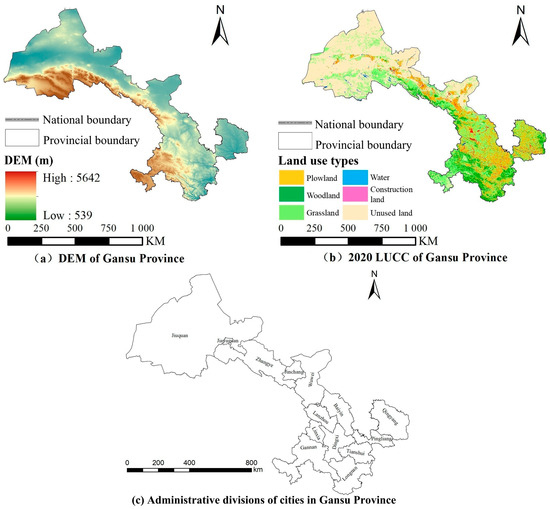
Figure 1.
The information of study area.
The data used in the research come from a number of data resource platforms, among which the administrative boundary vector data (2020), GDP raster data, etc., come from the Source Environ-mental Science and Data Center of Chinese Academy of Sciences, and the LUCC data are adopted from China’s Multi-period Remote Sensing Monitoring of Land Use dataset [25]; the meteorological data for Gansu Province come from the National Qinghai-Tibetan Plateau Scientific Data Center; the population raster data come from the Worldpop public dataset; the resource consumption data of the province in the socio-economic statistics come from the Statistical Yearbook and Water Resources Bulletin of Gnasu; and the DEM data adopt the ASTER GDEM 30m data of the American Aviation Administration (NASA). The DEM data are adopted from NASA’s ASTER GDEM 30m accuracy data, which are derived from the Geospatial Data Cloud Platform (GDCP). Soil-related parameter data were obtained from the HWSD dataset. In this study, the preliminary statistical analysis and pixel calculation of the data were carried out by the hydrological analysis, spatial statistics, and other functional modules of ArcGIS 10.2 software and Orgin2025, and the calculation of water conservation services was obtained by the InVEST 3.14.3.
2.2. Land Use Change Assessment
To accurately reflect changes in geospatial units over the study period, a land use transfer matrix is constructed based on the changes in land use types within the same unit between the initial and final observation periods, providing a clear visualization of the changes in various land categories throughout the study area [26]. Assuming there are n distinct land use types (in this study, six land use types were selected, namely plowland, woodland, grassland, water, construction land, and unused land), the land use transfer matrix can be represented as an matrix, where each element denotes the transition proportion or probability from land use type i to type j. This matrix serves as a valuable tool for analyzing and predicting trends and relationships among different land use changes. It holds significant application value in fields such as land planning, resource management, and environmental protection, enabling decision-makers to better understand the patterns of land surface change and track the evolving trends of ecosystem service functions.
2.3. Assessment Model of Water Conservation Carrying Capacity from a Supply–Demand Perspective
2.3.1. Water Conservation Supply Assessment Model
This study employs the Water Yield module within the InVEST model to estimate the water yield of individual grid cells in the study area, followed by a further calculation of the water conservation capacity at the regional grid level. The procedure is outlined as follows [27]:
In the above formula, represents the calculated water yield per grid cell (mm), refers to the actual evapotranspiration, and denotes the precipitation (mm) per grid cell. represents the Budyko aridity index, reflecting the ratio of potential evapotranspiration to precipitation; is the plant available water fraction of the grid cell; is the plant evapotranspiration coefficient; indicates the plant available water content (mm) of the grid cell; and stands for the Zhang coefficient, a factor reflecting seasonal rainfall characteristics. Following the study by Wei et al. [25], this parameter was set to 3.16.
Regional water conservation refers to the amount of precipitation retained in local soil through processes such as interception, absorption, and storage by various land use and land cover types. Therefore, based on the computed water yield, the physical quantity of water conservation in the study area was further calculated as follows [28]:
In the formula, represents the water conservation supply, denotes the water yield, is the flow velocity coefficient, refers to the topographic index, indicates the soil permeability rate, stands for the soil depth, while the total number of catchment grid cells and the slope percentage are both derived from ArcGIS-based hydrological analysis.
The assessment results of water conservation capacity were compared with the data in the water resources bulletins of previous years. It was found that the error was within the range of 5% to 15%, and the accuracy of the assessment results met the standards required for subsequent research.
2.3.2. Water Resources Demand Assessment Model
Regional water consumption consists of agricultural and industrial productive, domestic, and ecological water use. Based on data from the Gansu Provincial Water Resources Bulletin and Statistical Yearbook over the years, the water demand in the region was calculated as follows [29]:
In the formula, represents the total water demand, while , , , and denote the industrial, domestic, agricultural, and ecological water demand in the study area, respectively. represents the water use per CNY 10,000 GDP in grid cells, and denotes the per unit GDP. represents the per capita water consumption in grid cells, and denotes the per unit population. represents the water use in grid cells, and denotes the GDP. denotes the agricultural–ecological water demand per grid cell in the study area, and represents the number of plowland grid cells.
2.3.3. Assessment Model of Water Conservation Carrying Capacity
Water resource carrying capacity is a comprehensive concept, referring to the maximum capability of a regional water resources system within a given period and under specific technological, socio-economic, and developmental conditions to sustainably support socio-economic scales (including population, urban development, industry, and agriculture) and maintain ecological health. In simpler terms, it describes how many people, how much economic activity, and how well the ecological environment can be supported by the available water in a region.
Therefore, from the perspective of balancing the supply and demand of water conservation services in regional ecosystems, the water resource carrying capacity is reflected by establishing the Ratio of Supply–Demand (RSD) for water conservation. Based on the raster data such as the population and GDP of Gansu Province, the corresponding water resource demand is calculated. Based on the raster data from the supply side, the following formula [30] is applied to calculate the RSD in the region:
2.4. Spatial Clustering Analysis
To further reveal the supply–demand pattern of water conservation services in Gansu Province, a spatial hot spot analysis (Getis–Ord Gi*) was conducted to examine the spatial clustering characteristics of service supply, demand, and supply–demand surplus. The formula below illustrates the calculation process, where the Z-score indicates the intensity of clustering: a higher Z-score denotes a significant hot spot, while a lower Z-score suggests a pronounced cold spot. Here, represents the spatial weight between locations and , is the total number of areas, and refers to the attribute value of area [31].
3. Results
3.1. Changes in Land Use Types in Gansu Province
Based on Gansu Province’s land cover data, land use transition matrices were constructed for the period 2000–2020 at five-year intervals. Table 1, Table 2, Table 3 and Table 4 present the results of the land use transition matrices for the periods 2000–2005, 2005–2010, 2010–2015, and 2015–2020, respectively.

Table 1.
Land use transition matrix for Gansu Province during 2000–2005.

Table 2.
Land use transition matrix for Gansu Province during 2005–2010.

Table 3.
Land use transition matrix for Gansu Province during 2010–2015.

Table 4.
Land use transition matrix for Gansu Province during 2015–2020.
As shown in Table 1, in the year 2000, the most abundant land use type in Gansu Province was unused land, with a total of 183,680 km2, followed by grassland, with 172,203 km2. The number of patches of other land use types was significantly lower than these two. By 2005, among the land use types that underwent changes, the most notable transitions involved plowland: 1793 km2 were converted to grassland, while 1267 km2 of grassland were converted to plowland. The area of construction land expanded from 5664 km2 in 2000 to 6051 km2 in 2005. The increase in construction land primarily resulted from the encroachment on plowland and grassland. Additionally, ongoing ecological restoration projects in the region aimed at desert and Gobi unused land led to the conversion of 1146 km2 of unused land to plowland and 579 km2 to grassland.
During the period from 2005 to 2010, Gansu Province carried out significant development of unused land, with 1295 km2 converted to plowland, 2320 km2 to grassland, and 538 km2 to water bodies. Meanwhile, urban areas continued to expand, increasing from 6051 km2 in 2005 to 6814 km2 in 2010. From 2010 to 2015, the area of plowland decreased, primarily due to conversion to grassland, amounting to 1062 km2. Conversely, 1000 km2 of grassland were reclaimed for plowland under the influence of agricultural activities. By 2015, construction land had further increased to 7480 km2, reflecting continued urban expansion that mainly encroached on agricultural plowland, with a total of 447 km2 converted. During this period, the development of unused land continued, with 346 km2 converted to plowland, 345 km2 to grassland, and 221 km2 to construction land.
During the period from 2015 to 2020, land cover types in Gansu Province underwent intense changes. Only 59,854 km2 of plowland remained unchanged. As China continued to implement the Grain for Green and Grazing for Grass programs, 648 km2 of plowland were artificially converted to forest, and 7102 km2 were restored to grassland. Meanwhile, urban expansion intensified significantly. The area of construction land increased sharply from 7480 km2 in 2015 to 8751 km2 in 2020. This expansion involved the conversion of 1172 km2 of plowland and 546 km2 of grassland. Regarding the development of unused land, 891 km2 were reclaimed as plowland, 738 km2 were converted to water bodies, and 657 km2 were developed into construction land.
Figure 2 illustrates the transitions among the six major land types in Gansu Province from 2000 to 2020. As shown in the figure, the most significant area changes at five-year intervals occurred in plowland, grassland, and unused land, which were converted to other categories at notable scales. During 2000–2005, the primary transitions included the conversion of plowland to grassland, grassland to plowland, and unused land to plowland. In the period 2005–2010, changes were dominated by the transformation of plowland to grassland. Meanwhile, grassland was partly converted to plowland due to agricultural activities, but a larger portion degraded into unused land such as desert as a result of desertification. Desert restoration projects also achieved notable outcomes, with some unused land being reclaimed as plowland and even more being improved into grassland. Between 2010 and 2015, the overall scale of land transitions was relatively limited, with mutual conversion between plowland and grassland being the most common type of change. From 2015 to 2020, land cover transitions intensified significantly. A large portion of plowland was returned to grassland, while some forest areas experienced decreased vegetation density due to environmental degradation and were gradually converted to grassland. Grassland faced dual pressures from agricultural expansion and desertification risks. At the same time, desertification control projects continued, with most unused land being artificially greened and transformed into grassland.
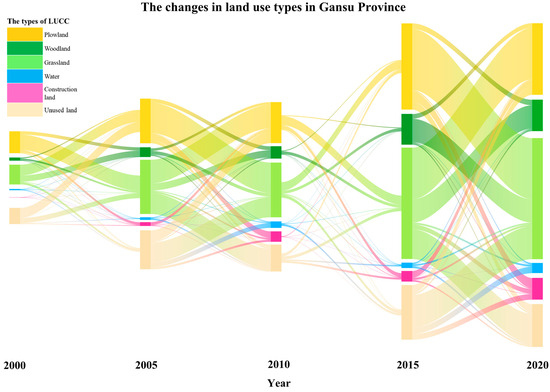
Figure 2.
Land use conversion in Gansu Province from 2000 to 2020.
3.2. The Assessment Results and Numerical Distribution Changes in Gansu Water Conservation from 2000 to 2020
Using the InVEST model and combining multi-source data such as evaporation and rainfall, the water conservation values of Gansu Province during the period from 2000 to 2020 were evaluated.
In terms of water conservation capacity, as shown in Figure 3, the maximum water conservation per pixel in Gansu Province was 7.89 × 105 m3 in the year 2000, which increased to 8.15 × 105 m3 by 2020. In contrast, the lowest value was recorded in 2015, at only 6.29 × 105 m3 per pixel. Spatially, both water yield and water conservation exhibited a distinct pattern of being “higher in the south and lower in the north” and “higher in the west and lower in the east”. Regions such as Lanzhou, Baiyin, Gannan, Longnan, Dingxi, Tianshui, and Linxia were identified as key areas with high water conservation capacity. Pixels with high water yield and conservation were predominantly distributed along the eastern Qilian Mountains and the southern Qinling Mountains.
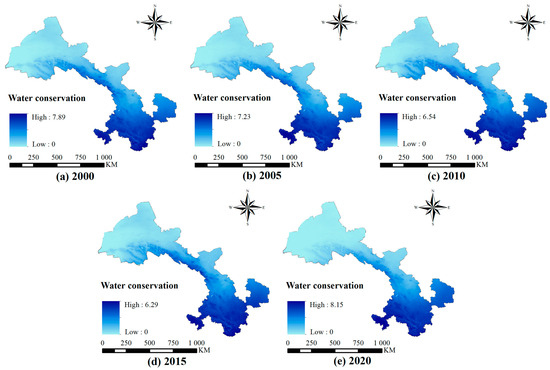
Figure 3.
Water conservation in Gansu in the years 2000, 2005, 2010, 2015, and 2020 (the units of the numerical results in the figure are all 105 m3).
Based on LUCC data, forests and grasslands in Gansu are mainly concentrated in the southern Qinling and eastern Qilian Mountain regions. The high vegetation coverage in these areas enhances the retention and conservation of natural rainfall and surface water resources, contributing significantly to regional water balance. However, a comparison between the years 2000 and 2020 reveals noticeable ecosystem degradation in northern Gansu, where water conservation capacity has further declined. Moreover, due to urban expansion, construction land has increasingly encroached on forest and grassland areas. As a result, the water conservation service capacity has also decreased in major urban centers, including Lanzhou.
Figure 4 illustrates the changes in water conservation service levels during the study period. Compared to the year 2000, by 2005, Gansu Province exhibited a significant decline in its water conservation capacity, with the maximum decrease per unit pixel reaching 0.92 × 105 m3. In terms of the overall spatial pattern, aside from the unused land areas such as deserts and Gobi in the central and northern regions, the decline was primarily concentrated along the urban corridors of Lanzhou, Zhangye, Jinchang, and Wuwei. The Qilian Mountains region in northwestern Gansu also experienced a decrease in water conservation capacity; it was not severe. During this period, the continuous expansion of these central cities encroached upon surrounding natural ecological covers, such as grasslands, leading to a reduction in the ecosystem’s water conservation capacity in these areas. Between 2000 and 2005, only the Gannan region in the southwest continued to show an increase in water conservation service levels, with the maximum increase per unit pixel reaching 1.01 × 105 m3.
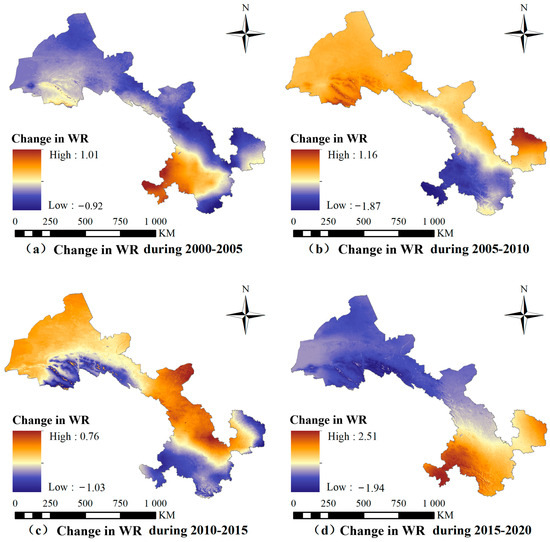
Figure 4.
Water conservation supply during 2000–2020 (the units of the numerical results in the figure are all 105 m3).
During the two periods of 2005–2010 and 2010–2015, the spatial patterns of changes in water conservation services within Gansu Province’s ecosystems exhibited overall similarities. Increases in water conservation per unit were observed in the desert regions of the northwest and in areas such as Baiyin and Dingxi in the east. The maximum increase per unit pixel reached 1.16 × 105 m3 during 2005–2010 and 0.76 × 105 m3 during 2010–2015. In contrast, the decline was concentrated in the Gannan region. Notably, the Qilian Mountains area showed a significant decrease during 2010–2015, indicating a risk of vegetation cover degradation in these regions.
Between 2015 and 2020, two contrasting trends emerged: a decline and an increase. A distinct north–south divergence pattern was observed. The water conservation capacity of ecosystems in the northern region showed a significant decrease, with the Qilian Mountains continuing the trend seen during the 2010–2015 period and experiencing a notable decline, reaching a maximum unit value of 1.94 × 105 m3. In contrast, areas with increased water conservation remained concentrated in the southern regions, such as Gannan, Longnan, and Tianshui, which are characterized by high vegetation coverage, with a maximum unit value of 2.51 × 105 m3. During this period, the overall water conservation capacity of ecosystems in Gansu Province weakened. Moreover, the ecosystem services provided by central cities have significantly eroded the surrounding ecological functions, particularly exacerbating the deterioration in key mountainous areas of northern Gansu Province.
3.3. Changes in Water Conservation Carrying Capacity of Gansu Province
Based on the assessment of annual water conservation supply and demand in Gansu Province during the study period, and through the integration of a water conservation carrying capacity model with raster data calculations, the RSD results at the pixel scale were ultimately obtained. The specific spatial distribution is shown in Figure 5. In the figure, deeper shades of blue-green indicate lower RSD values, suggesting a higher risk of imbalance between water conservation supply and demand in the area. Deeper shades of brown indicate that the water conservation supply significantly exceeds demand, corresponding to higher RSD values and a lower risk of supply–demand imbalance.
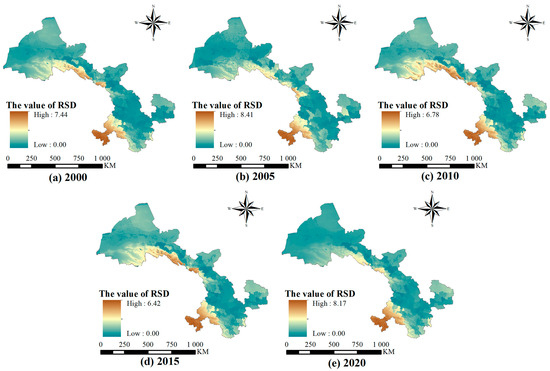
Figure 5.
Results of water resources carrying capacity in Gansu Province (the minimum value of 0.00 in the figure was approximated based on the RSD value).
In 2000, the maximum RSD value per pixel in Gansu Province was 7.44. Pixels with a low risk of supply–demand imbalance were mainly concentrated in the southwestern mountainous areas of Gannan Prefecture and parts of the Qilian Mountains in the northwest. The minimum RSD values were close to 0. Such pixels were predominantly distributed in highly urbanized areas, forming a high carrying pressure belt extending northwest–southeast across central Gansu, including cities such as Jiayuguan, Zhangye, Jinchang, Wuwei, and Lanzhou, as well as a deficit zone stretching southwest–northeast in the southeast, composed of cities such as Tianshui, Pingliang, and Qingyang.
By 2020, the spatial distribution of RSD values at the pixel level had undergone significant changes compared to 2000. Although the maximum value per pixel increased to 8.17, the overall area with high-value pixels shrank and remained mainly concentrated in the southwestern Gannan Autonomous Prefecture. Meanwhile, the proportion of high RSD pixels along the Qilian Mountains in the northwest decreased noticeably, indicating an increasing pressure on water conservation capacity in this region during the study period. Human social activities have already caused certain impacts in this area. Spatially, regions with high risk of water conservation carrying capacity imbalance were concentrated around Lanzhou City. During this period, with economic growth and population concentration in urban core areas across the province, water conservation demand became highly concentrated in regions with intensive industrial and domestic water use, such as Lanzhou. As a result, deficit pixels showed a more densely clustered distribution within urban areas.
Figure 6 illustrates the changes in the RSD values of water conservation in Gansu Province between different time nodes during the study period. As shown in the figure, from 2000 to 2005, the RSD values exhibited a decreasing trend, indicating an overall aggravation of the risk of imbalance between water conservation supply and demand. A few areas with significant RSD increases were concentrated in forest-covered regions along the border between Zhangye and Wuwei cities in central Gansu. In terms of numerical changes, the maximum increase per pixel reached 5.00, while the maximum decrease was 3.62. During the periods 2005–2010 and 2010–2015, the overall RSD values in Gansu Province showed an upward trend, suggesting a mitigation of the water conservation supply–demand imbalance risk across the region during these intervals. However, consistent with earlier single time node RSD results, the Qilian Mountains region in the northwest experienced a decline in the RSD during 2010–2015, which heightened the risk of carrying capacity imbalance. From 2015 to 2020, this pattern continued: northern and central Gansu generally showed decreased RSD values, while the southern part—except for significant increases in Gannan Prefecture—only registered minor improvements. The maximum increase per pixel reached 4.43, while the maximum decrease was 3.72. These findings indicate that during this period, the overall supply–demand relationship of water conservation in Gansu Province faced an elevated risk of imbalance, accompanied by increased pressure on the ecological environment carrying capacity.
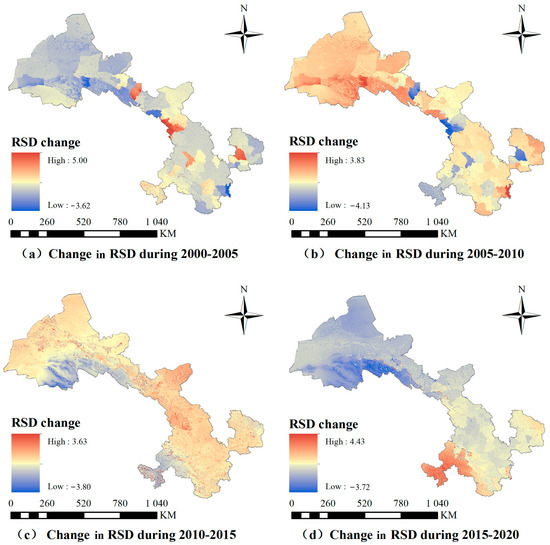
Figure 6.
The numerical variation in the ratio of supply–demand.
3.4. Spatial Aggregation and Evolution Characteristics
Figure 7 presents the results of the cold spot and hot spot analysis (p < 0.01) for the changes in water conservation supply–demand surplus across various prefectures in Gansu Province during the periods 2000–2005, 2005–2010, 2010–2015, and 2015–2020. The maps reveal that the water conservation capacity of the province underwent significant dynamic changes throughout the study intervals.
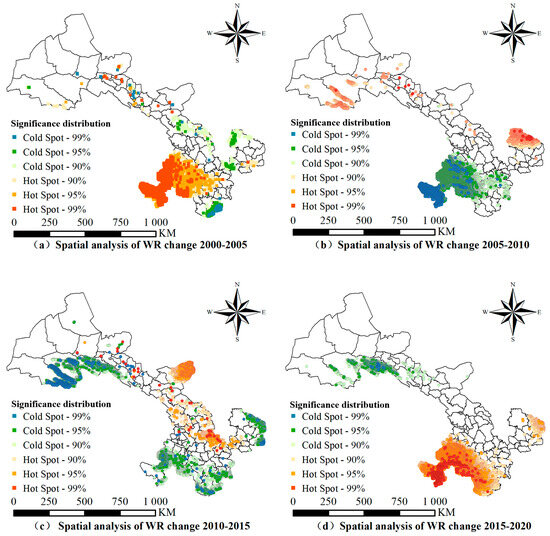
Figure 7.
Results of the spatial variation in water conservation supply (p < 0.01).
During 2000–2005, no pronounced cold or hot spot clusters were observed in the central and northern parts of the province. In contrast, significant hot spot clustering was identified in Gannan Prefecture in the southwest, indicating an improvement in ecosystem-based water conservation supply and relatively high water retention capacity in this region. Conversely, cold spot clusters emerged along the border between Longnan Prefecture in southern Gansu and Sichuan Province, suggesting a declining trend in local water conservation capacity. Notably, in the Hexi Corridor—a region typically characterized by water supply–demand deficits—the spatial pattern of change was heterogeneous, with both cold and hot spots coexisting without a clear aggregated trend. From 2005 to 2010, marked spatial differentiation appeared across the province. Some areas in the northern Qilian Mountains exhibited linear hot spot clusters, reflecting recovered ecosystem conditions and enhanced water conservation capacity during this period. Meanwhile, Gannan Prefecture showed concentrated cold spot clusters, signaling elevated hydro-ecological risks likely due to the degradation of natural ecosystems such as forests and grasslands, which led to a decline in water conservation services. In eastern Gansu, counties including Huanxian and Huachi in Qingyang City displayed hot spot clustering. Between 2010 and 2015, degradation of water conservation services became more evident along the Qilian Mountains in northwestern Gansu, where significant loss of water supply capacity intensified local hydro-ecological risks. Concurrently, cold spot clusters were widespread in southern Gannan Prefecture and eastern Qingyang City. In the period 2015–2020, ecological conservation initiatives such as the protection of the Yellow River source area contributed to the recovery of ecosystem functions and water conservation services in Gannan and Qingyang. However, ecological risks remained severe in the Qilian Mountains region, where cold spots were predominantly distributed around the junction of Jiuquan, Jiayuguan, and Zhangye cities. Moreover, a spreading trend of degradation was observed along the Hexi Corridor toward central Zhangye, including counties such as Gaotai and Minze.
Spatial aggregation characteristics of the RSD (p < 0.05) changes in Gansu Province at five-year intervals were also analyzed, and the results are shown in Figure 8. The maps indicate that during 2000–2005, a distinct “hot in the south, cold in the north” spatial clustering pattern emerged. Hot spots were concentrated in Wuwei, Qingyang, Gannan, and Dingxi, while cold spots were predominantly observed in arid northern cities such as Jiuquan, Zhangye, and Jiayuguan, where desert landscapes cover a large proportion of the area.
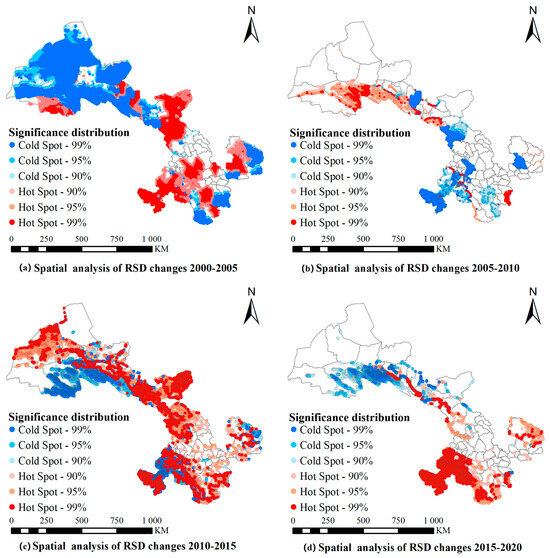
Figure 8.
The spatial agglomeration distribution of changes in water resources carrying capacity during 2000–2020 (p < 0.05).
From 2005 to 2010, spatial clustering became more concentrated. Hot spots were mainly distributed along the northern Qilian Mountains, whereas cold spots appeared in the western counties of Wuwei and the western part of Gannan. During 2010–2015, hot spot clustering of the RSD became dominant and was widely distributed across most regions of Gansu. In contrast, cold spots were identified in the Qilian Mountains area in the northwest. By 2015–2020, the spatial evolution of the RSD showed clearer patterns. Consistent with numerical trends, hot spots were primarily clustered in the southwestern Gannan region. Meanwhile, cold spots in the Qilian Mountains shifted southeastward, expanding into Jiayuguan and northwestern Zhangye. This spatiotemporal aggregation pattern of the RSD aligns with the trajectory of urban development in Gansu Province. The population is largely concentrated in central and western cities such as Lanzhou, Tianshui, and Wuwei. Population growth and urban expansion have increased the demand for water conservation services from surrounding ecosystems. However, increased emphasis on ecological protection—particularly given Gansu’s role as a key conservation area for the source region of the Yellow River—has led to the implementation of afforestation and desert restoration projects. These efforts have contributed to partially alleviating pressure on water conservation capacity.
4. Discussion
4.1. Urban Expansion and Regional Water Conservation Carrying Capacity Risks
This study evaluated long-term water yield and conservation dynamics in Gansu Province. Model validation was performed through cross-comparison with official hydrological data and published research. The estimated water conservation volume showed a relative error of 5–15% when compared with surface runoff and total water resources reported in the Gansu Water Resources Bulletin (2000–2020), meeting the required accuracy standards. Spatially, the results align with Pu et al. [32], who identified a “high in the northwest, low in the southeast” pattern in ecosystem service supply in the Qilian Mountains—consistent with the concentration of high water conservation values in the northwestern part of the region, thereby supporting the spatial credibility.
Assessment of the spatial pattern of water conservation supply and demand in Gansu Province reveals a prominent coexistence of water scarcity and spatial mismatch across the region, with supply–demand deficits concentrated primarily in central urban areas such as Lanzhou and Tianshui. Continued population growth and industrial agglomeration have further intensified water resource competition in these regions, increasing the risk of systemic overload in aquatic ecosystems. Rapid urbanization has directly altered regional ecological structure through the encroachment of construction land on natural ecological spaces such as grasslands and wetlands, resulting in surface hardening, reduced rainwater infiltration, and significantly diminished natural water conservation functionality. This is particularly evident in the Hexi Corridor and central Longzhong region, where urban expansion not only reduces ecological water allocation but also exacerbates local water shortages through rising domestic and industrial consumption. Land use change analyses indicate that between 2000 and 2020, built-up expansion in regional centers such as Lanzhou involved substantial conversion of surrounding cropland and grassland, directly contributing to the decline in regional water conservation capacity and aggravating supply–demand imbalance and spatial mismatch.
Urban expansion not only consumes ecological space directly but also imposes multi-faceted risks on regional water conservation carrying capacity by altering hydrological processes and increasing water demand. To mitigate water supply–demand conflicts in Gansu, it is essential to strictly delineate urban development boundaries and aquatic ecological protection redlines within territorial spatial planning, thereby achieving coordinated development between urbanization and sustainable water resource utilization. Recent trends in regional water conservation research emphasize moving beyond single-dimensional supply-side assessments toward coupled human–water system analysis, particularly in arid and semi-arid regions like Gansu. There is growing focus on the spatial optimization of land use and dynamic zoning of ecological functions to mitigate urbanization pressures. In response, adaptive strategies are increasingly combining remote sensing-based early warning systems with land use regulation—such as strictly delineating urban growth boundaries and aquatic ecological protection redlines within territorial spatial planning. Furthermore, the integration of nature-based solutions into urban and watershed planning is considered critical to enhancing infiltration and restoring hydrological regulation capacity. Implementing such integrative approaches will be essential to achieving coordinated development between urbanization and sustainable water resource utilization in water-stressed regions.
4.2. Water Ecological Security Risk Management Recommendations
Based on the spatial analysis of water conservation supply and demand in Gansu Province, the ecological security pattern in the Qilian Mountains region has undergone significant fluctuations, with a continuous decline in water conservation capacity observed between 2010 and 2020. Concurrently, Gannan Prefecture in the southwest also faced severe ecological degradation risks from 2005 to 2015. Growing water demand in major cities along the Hexi Corridor has further intensified pressures on the provincial water–ecological security system. To address ecological risks stemming from declining water conservation capacity and intensified human activities, an integrated management system combining zonal regulation, dynamic monitoring, and risk early warning should be established. The following recommendations are proposed:
Firstly, implement differentiated land use management strategies. In key water conservation areas such as the Qilian Mountains and Gannan Plateau, strictly control industrial and mining activities as well as cropland expansion, and promote grazing withdrawal, grassland restoration, and cropland-to-forest conversion to maintain the proportion of ecological land. In regions with prominent water supply–demand conflicts such as the Hexi Corridor, delineate urban growth boundaries and limit the proportion of impervious surfaces to prevent further loss of ecological land.
Secondly, optimize the spatial distribution of population and industry. In major cities such as Lanzhou and Tianshui enforce strict total water use redlines and guide water-intensive industries to relocate to nodes with relatively abundant water resources, such as Zhangye and Wuwei. In ecologically fragile areas like the Loess Plateau of central Gansu, implement ecological migration and settlement consolidation programs.
Thirdly, establish a comprehensive ecological and environmental risk prevention system. Utilize remote sensing and other monitoring technologies to conduct real-time, multi-period surveillance of groundwater over-extraction in critical basins such as the Shiyang River and Heihe River, enabling early warning based on water level thresholds. Implement dual-control systems for both water quality and quantity along the main stem of the Yellow River in Gansu to ensure water source health and sustainability.
Particular attention should be given to regions with high water resource carrying capacity risks (RSD < 1), such as the central urban agglomerations and the Hexi Corridor. In these areas, it is essential to strengthen the dynamic assessment of water resource carrying capacity, delineate groundwater over-exploitation zones, and promote the use of reclaimed water and smart water-saving technologies. Ecological restoration in desertification-prone areas should be integrated with urban spatial planning, embedding water conservation goals into urban development policies to achieve a balance between urbanization growth and water sustainability.
4.3. Limitations and Future Research Directions
This study examines the impact of land use change on the spatial pattern of water ecological carrying capacity, with a specific focus on water conservation services. Limited by data resolution, a 1 km pixel size was adopted, which may affect the identification of fine spatial details. Furthermore, while the current assessment primarily addresses water conservation services, it does not incorporate other ecosystem functions critical to water ecological security, such as water purification and soil retention. Future research will expand the range of services evaluated and establish a more comprehensive ecosystem service assessment framework to enhance the integrated evaluation of water ecological security in Gansu Province.
In addition, as quantitative ecosystem service assessments largely rely on LUCC data, changes in land cover types directly influence the supply capacity of regional ecosystem services. Accordingly, subsequent studies will focus on the effects of land cover change on key ecological functional zones, with in-depth analysis of natural and anthropogenic driving factors—particularly the stress effects of urbanization on ecosystem health. The findings aim to provide a scientific basis and long-term strategic support for optimizing ecological resource management and implementing zoning governance for ecological security.
5. Conclusions
Based on the theory of ecosystem services, this study applied the InVEST model and ArcGIS-based geospatial analysis to quantitatively assess water conservation—a key ecosystem supply service—across Gansu Province from 2000 to 2020. From a supply–demand perspective, the study visually reveals the evolution of hydro-ecological security patterns in the region during this period. The results indicate the following:
Urban expansion has significantly exacerbated the imbalance between water supply and demand in key regions of Gansu Province. The encroachment of construction land on ecological spaces such as forests and grasslands—particularly around urban centers like Lanzhou—has reduced natural water conservation capacity, while continued population growth and industrial agglomeration have further increased local water consumption. This dual pressure has resulted in a pronounced spatial mismatch: critical ecological functional areas such as the Qilian Mountains and southern Gannan still maintain relatively high water conservation capacity, whereas urbanized zones along the Hexi Corridor, including Zhangye, Jiayuguan, and Lanzhou, have become high-risk areas for water resource carrying capacity imbalance.
Temporal analysis further indicates that water conservation services in the Qilian Mountains experienced significant degradation between 2010 and 2015. Although some recovery occurred in southern regions such as Gannan and Qingyang from 2015 to 2020, northwestern Gansu continues to face severe ecological risks, with water scarcity hot spots expanding along the Hexi Corridor.
Uncontrolled urban expansion poses multi-dimensional threats to water ecological carrying capacity by diminishing supply through land cover changes while simultaneously driving up demand. Achieving sustainable water resource management in rapidly urbanizing regions like Gansu requires strictly delineating ecological protection redlines, controlling urban boundary expansion, and optimizing the spatial distribution of population and industry.
Author Contributions
K.H.: Data curation, methodology, writing—original draft. Z.S.: Data curation, software, writing—original draft. M.Z.: Supervision, project administration. Z.Q.: Writing—review and editing. Q.S.: Supervision, writing—review and editing. All authors have read and agreed to the published version of the manuscript.
Funding
This research was supported by a High-Level Talent Supporting Fund of Xiangnan University, Grant No. 6012401; High-Level Talent Supporting Fund of Suzhou Institute of Trade & Commerce, No. 705S104.
Data Availability Statement
The data presented in this study are available upon request from the corresponding author.
Acknowledgments
We thank the reviewers and editors during the review process.
Conflicts of Interest
The authors declare no conflicts of interest.
References
- Costanza, R.; Groot, R.; Sutton, P.; van der Ploeg, S.; Anderson, S.J.; Kubiszewski, I.; Farber, S.; Turner, R.K. Changes in the global value of ecosystem services. Glob. Environ. Change 2014, 26, 152–158. [Google Scholar] [CrossRef]
- Castellano, C.; Bruno, D.; Comín, F.A.; Rey Benayas, J.M.; Masip, A.; Jiménez, J.J. Environmental drivers for riparian restoration success and ecosystem services supply in Mediterranean agricultural landscapes. Agric. Ecosyst. Environ. 2022, 337, 108048. [Google Scholar] [CrossRef]
- Eric, D.; Agbeko, P.M.D.; Bapentire, D.A. Assessment of wetland ecosystem services and human wellbeing nexus in sub-Saharan Africa: Empirical evidence from a socio-ecological landscape of Ghana. Environ. Sustain. Indic. 2022, 15, 100186. [Google Scholar]
- Yao, W.; Wang, X.; Jia, Z.; Wang, X.; Zhang, X.; Feng, X.; Zhou, J.; Ma, J.; Tu, Y.; Liu, X.; et al. Reconciling ecosystem service supply-demand mismatches through ecological compensation in the Tibetan plateau. Carbon Balance Manag. 2025, 20, 30. [Google Scholar] [CrossRef]
- Alshayeb, J.M. Evaluating Ecosystem Service Trade-Offs and Recovery Dynamics in Response to Urban Expansion: Implications for Sustainable Management Strategies. Sustainability 2025, 17, 2194. [Google Scholar] [CrossRef]
- Katerina, V. Evaluation of Ecosystem Services Loss Due to Urban Sprawl on Agricultural Land in the Context of Sustainable Development. J. Landsc. Ecol. 2020, 13, 122–133. [Google Scholar] [CrossRef]
- Zhang, H.; Zheng, J.; Hunjra, A.I.; Zhao, S.; Bouri, E. How does urban land use efficiency improve resource and environment carrying capacity? Socio-Econ. Plan. Sci. 2024, 91, 101760. [Google Scholar] [CrossRef]
- Świąder, M.; Lin, D.; Szewrański, S.; Kazak, J.K.; Iha, K.; Van Hoof, J.; Belčáková, I.; Altiok, S. The application of ecological footprint and biocapacity for environmental carrying capacity assessment: A new approach for European cities. Environ. Sci. Policy 2020, 105, 56–74. [Google Scholar] [CrossRef]
- You, H.; Xu, F.; Yan, J.; Guo, X. Effects of trial urban growth boundary delineation on land carrying capacity in China. Humanit. Soc. Sci. Commun. 2025, 12, 609. [Google Scholar] [CrossRef]
- Gao, Y.; Shen, Z.; Zhang, T.; Liu, Y. Integrating ecosystem service bundles and scenario predicting for win-win sustainable urban management: A case study of typical arid cities in China. Cities 2025, 166, 106248. [Google Scholar] [CrossRef]
- Zeng, J.; Cui, X.; Chen, W.; Yao, X. Impact of urban expansion on the supply-demand balance of ecosystem services: An analysis of prefecture-level cities in China. Environ. Impact Assess. Rev. 2023, 99, 107003. [Google Scholar] [CrossRef]
- Wang, H.; Sun, Q. Urban Sprawl and Imbalance between Supply and Demand of Ecosystem Services: Evidence from China’s Yangtze River Delta Urban Agglomerations. Sustainability 2024, 16, 8269. [Google Scholar] [CrossRef]
- Aoudia, A.N.M. Design and sustainability assessment of water strategy scenarios based on resource carrying capacity and multi-criteria decision-making: The case of Algiers. Util. Policy 2025, 96, 101987. [Google Scholar] [CrossRef]
- Mostafa, K.; Mehdi, M.B.; Pieter, O.V. A mathematical meta-model for assessing the self-sufficient water resources carrying capacity across different spatial scales in Iran. Heliyon 2023, 9, e15079. [Google Scholar]
- Wu, Z.; Fan, Y.; Zhang, S.; Qian, X.; Wang, G. Dynamic assessment of water resources carrying capacity under human impacts on the water cycle: A finer perspective at the spatiotemporal scale of basin. J. Clean. Prod. 2025, 486, 144602. [Google Scholar] [CrossRef]
- Shen, J.; Nie, Y.; Huang, X.; Ma, M. Comprehensive Assessment of Water Resource Carrying Capacity Based on Improved Matter–Element Extension Modeling. Water 2025, 17, 1197. [Google Scholar] [CrossRef]
- Xu, R.; Liu, L.; Liu, Y.; Yi, X.; Qiu, H. Multi-scenario modelling of urban spatial growth under water resources and aquatic ecological environmental constraints. Ecol. Indic. 2025, 177, 113803. [Google Scholar] [CrossRef]
- Kimbi, S.B.; Onodera, S.-I.; Wang, K.; Kaihotsu, I.; Shimizu, Y. Assessing the Impact of Urbanization and Climate Change on Hydrological Processes in a Suburban Catchment. Environments 2024, 11, 225. [Google Scholar] [CrossRef]
- Fouad, S.S.; Heggy, E.; Abotalib, A.Z.; Ramah, M.; Jomaa, S.; Weilacher, U. Landscape-based regeneration of the Nile Delta’s waterways in support of water conservation and environmental protection. Ecol. Indic. 2022, 145, 109660. [Google Scholar] [CrossRef]
- Yang, H.; Wang, Y.; Tu, P.; Zhong, Y.; Huang, C.; Pan, X.; Xu, K.; Hong, S. Evaluating the effects of future urban expansion on ecosystem services in the Yangtze River Delta urban agglomeration under the shared socioeconomic pathways. Ecol. Indic. 2024, 160, 111831. [Google Scholar] [CrossRef]
- Guan, D.; Fan, X.; Zhou, L.; Zhu, K. Quantitative assessment of the supply, demand and flows of ecosystem services in the Yangtze River Basin, China. Front. Earth Sci. 2024, 18, 422–445. [Google Scholar] [CrossRef]
- Saleem, A.; Mahmood, I.; Sarjoughian, H.; Nasir, H.A.; Malik, A.W. A Water Evaluation and Planning-based framework for the long-term prediction of urban water demand and supply. Simulation 2021, 97, 323–345. [Google Scholar] [CrossRef]
- Zhu, D.W.; Na, D.; Wen, Z.Y. Land use change and its driving factors in the ecological function area: A case study in the Hedong Region of the Gansu Province, China. J. Arid Land 2024, 16, 71–90. [Google Scholar]
- Zhu, X.; Pan, J. Can biodiversity and ecosystem services be enhanced by existing conservation policies? A case study in Gansu Province, China. J. Nat. Conserv. 2025, 87, 126960. [Google Scholar] [CrossRef]
- Peng, S.Z.; Ding, Y.X.; Wen, Z.M.; Chen, Y.M.; Cao, Y.; Ren, J.Y. Spatiotemporal change and trend analysis of potential evapotranspiration over the Loess Plateau of China during 2011–2100. Agric. For. Meteorol. 2017, 233, 183–194. [Google Scholar] [CrossRef]
- Baccari, N.; Hamza, M.H.; Slama, T.; Sebei, A.; Ouerghi, S.; Elsheikh, R.; Rebai, N.; Hasanean, H.; Almazroui, M.; Elhag, M. Assessment of Machine Learning Techniques in Mapping Land Use/Land Cover Changes in a Semi-Arid Environment. Earth Syst. Environ. 2025, 9, 519–539. [Google Scholar] [CrossRef]
- Wei, P.J.; Wu, M.H.; Jia, Y.L.; Gao, Y.; Xu, H.; Liu, Z.; Chen, S. Spatiotemporal variation of water yield in the upstream regions of the Shule River Basin using the InVEST Model. Acta Ecol. Sin. 2022, 42, 6418–6429. [Google Scholar] [CrossRef]
- Shen, M.S.; Liu, Y.Y.; Zheng, H.; Chen, J. Evaluation of Water Source Conservation Service Value and Its Spatial Transfer in Yangtze River Basin. J. Chang. River Sci. Res. Inst. 2024, 41, 14–22+36. [Google Scholar]
- Wang, F.; Wu, Y.; Zhang, Y.; Wang, J.; Xue, Z.; Tan, X.; Jia, W. Research on ecosystem service value and landscape ecological risk prediction and zoning: Taking Fujian province as an example. Ecol. Model. 2025, 507, 111173. [Google Scholar] [CrossRef]
- Fu, S.; Zhang, J.; Li, Y.; Chen, W.; Zhang, Y.; Yi, K.; Dai, Y. Environmental variables affect the effectiveness of ecosystem services of ecological restoration project: Evidence from Xiangjiang River Basin-Dongting Lake. J. Clean. Prod. 2025, 527, 146739. [Google Scholar] [CrossRef]
- Fan, Y.; Yu, Y.; Song, T.; Yan, Q.; Zhang, Y.; Yang, Y.; Tian, P. Evaluation of water resources carrying capacity in the Yellow River Basin: A Hu Huanyong Line perspective. J. Water Clim. Change 2025, 16, 2241–2258. [Google Scholar] [CrossRef]
- Pu, L.; Lu, C.; Yang, X.; Chen, X. Spatio-Temporal Variation of the Ecosystem Service Value in Qilian Mountain National Park (Gansu Area) Based on Land Use. Land 2023, 12, 201. [Google Scholar] [CrossRef]
Disclaimer/Publisher’s Note: The statements, opinions and data contained in all publications are solely those of the individual author(s) and contributor(s) and not of MDPI and/or the editor(s). MDPI and/or the editor(s) disclaim responsibility for any injury to people or property resulting from any ideas, methods, instructions or products referred to in the content. |
© 2025 by the authors. Licensee MDPI, Basel, Switzerland. This article is an open access article distributed under the terms and conditions of the Creative Commons Attribution (CC BY) license (https://creativecommons.org/licenses/by/4.0/).